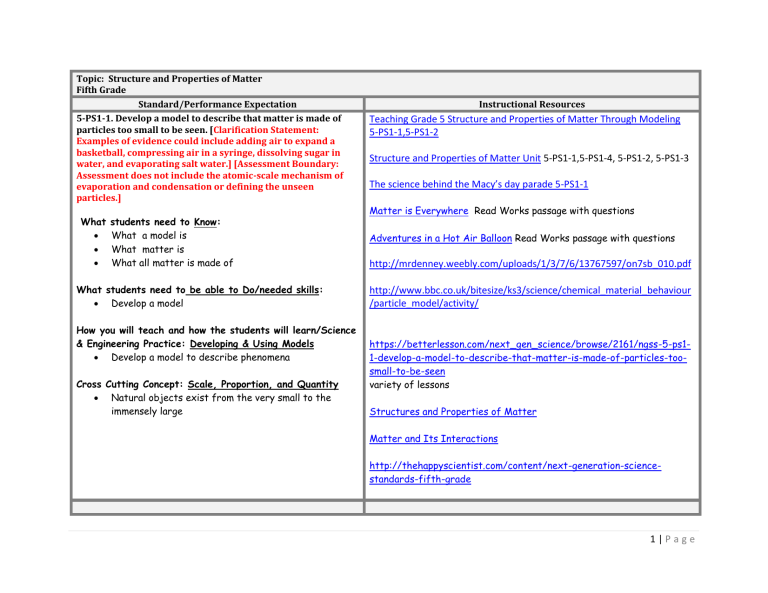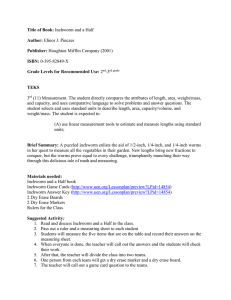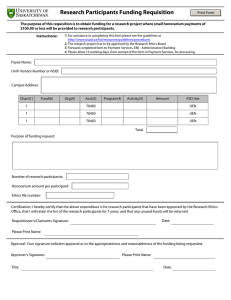
Topic: Structure and Properties of Matter Fifth Grade Standard/Performance Expectation 5-PS1-1. Develop a model to describe that matter is made of particles too small to be seen. [Clarification Statement: Examples of evidence could include adding air to expand a basketball, compressing air in a syringe, dissolving sugar in water, and evaporating salt water.] [Assessment Boundary: Assessment does not include the atomic-scale mechanism of evaporation and condensation or defining the unseen particles.] What students need to Know: What a model is What matter is What all matter is made of What students need to be able to Do/needed skills: Develop a model How you will teach and how the students will learn/Science & Engineering Practice: Developing & Using Models Develop a model to describe phenomena Cross Cutting Concept: Scale, Proportion, and Quantity Natural objects exist from the very small to the immensely large Instructional Resources Teaching Grade 5 Structure and Properties of Matter Through Modeling 5-PS1-1,5-PS1-2 Structure and Properties of Matter Unit 5-PS1-1,5-PS1-4, 5-PS1-2, 5-PS1-3 The science behind the Macy’s day parade 5-PS1-1 Matter is Everywhere Read Works passage with questions Adventures in a Hot Air Balloon Read Works passage with questions http://mrdenney.weebly.com/uploads/1/3/7/6/13767597/on7sb_010.pdf http://www.bbc.co.uk/bitesize/ks3/science/chemical_material_behaviour /particle_model/activity/ https://betterlesson.com/next_gen_science/browse/2161/ngss-5-ps11-develop-a-model-to-describe-that-matter-is-made-of-particles-toosmall-to-be-seen variety of lessons Structures and Properties of Matter Matter and Its Interactions http://thehappyscientist.com/content/next-generation-sciencestandards-fifth-grade 1|Page 5-PS1-2. Measure and graph quantities to provide evidence that regardless of the type of change that occurs when heating, cooling, or mixing substances, the total weight of matter is conserved. [Clarification Statement: Examples of reactions or changes could include phase changes, dissolving, and mixing that forms new substances.] [Assessment Boundary: Assessment does not include distinguishing mass and weight.] What students need to Know: How to measure How to graph What evidence is What quantities mean How matter can be changed The types of changes to matter What conserved means Mass and weight are considered the same in elementary What students need to be able to Do/needed skills: Measure and graph quantities to provide evidence How Students will Learn/Science & Engineering Practice: Using Mathematics and Computational Thinking Measure and graph quantities such as weight to address scientific and engineering questions and problems Crosscutting Concept: Scale, Proportion, and Quantity Instructional Resources: Ice Cubes in a Bag 5-PS1-2 Also open and closed systems https://betterlesson.com/next_gen_science/browse/2162/ngss-5-ps1-2measure-and-graph-quantities-to-provide-evidence-that-regardless-of-thetype-of-change-that-occurs-when-heating-coo variety of lessons http://www.uen.org/Lessonplan/preview?LPid=631 http://www.uen.org/Lessonplan/preview?LPid=26725 http://www.uen.org/Lessonplan/preview?LPid=28360 http://www.uen.org/Lessonplan/preview?LPid=2685 http://www.uen.org/Lessonplan/preview?LPid=2686 http://www.uen.org/Lessonplan/preview?LPid=16250 Shaking Water 5-PS1-2 http://www.nclark.net/conservation_of_matter_lab.pdf http://www.asminternational.org/content/CityOfMaterials/pdfs/9%20Conservation%20of%20Matter%205.09.10.pdf http://blog.teachersource.com/2010/10/05/simple-conservation-of-massactivity/ Ice Melting Blocks for this activity are at ISC. Email paula.roll@covington.kyschools.us if you would like to use them. 2|Page Standard units are used to measure and describe physical quantities such as weight, time, temperature, and volume Common Core Writing Connection W5.7 Conduct short research projects that use several sources to build knowledge through investigation of different aspects of a topic http://www.sciencefix.com/home/2011/11/24/conservation-of-matterheavy-whipping-cream.html http://thehappyscientist.com/content/next-generation-science-standardsfifth-grade scroll down to 5-PS1-2 W.5.8 Gather relevant information from print and digital sources; summarize or paraphrase information in notes and finished work, and provide a list of sources. W.5.9 Draw evidence from informational texts to support analysis, reflection, and research. 5-PS1-3. Make observations and measurements to identify materials based on their properties. [Clarification Statement: Examples of materials to be identified could include baking soda and other powders, metals, minerals, and liquids. Examples of properties could include color, hardness, reflectivity, electrical conductivity, thermal conductivity, response to magnetic forces, and solubility; density is not intended as an identifiable property.] [Assessment Boundary: Assessment does not include density or distinguishing mass and weight.] What students need to Know: How to make observations How to measure What is meant by properties Instructional Resources: Cinderella Separates a Mixture 5-PS1-3 Taking the Mystery out of Argument 5-PS1-3 http://www.inquiryinaction.org/classroomactivities/activity.php?id=22 http://www.teachingideas.co.uk/science/materialproperties.htm http://www.bbc.co.uk/schools/scienceclips/ages/7_8/characteristics_mat erials.shtml http://www.edu.gov.mb.ca/k12/cur/science/found/5to8/5c2.pdf 3|Page What students need to be able to Do/needed skills: Make observations and measurements to identify materials based on their properties How students will learn/Science & Engineering Practice: Planning and Carrying out Investigations Make observations and measurements to produce data to serve as the basis for evidence for an explanation of a phenomenon Cross Cutting Concept: Scale, Proportion, and Quantity Standard units are used to measure and describe physical quantities such as weight, time, temperature, and volume http://www.education.com/science-fair/article/mystery-powders/ (does not include data sheets-you will have to create these) http://cstl-csm.semo.edu/coleman/OpSci/Mystery%20Powder&DS.pdf (has recording sheets) Mystery Substances (has data sheets) https://betterlesson.com/next_gen_science/browse/2163/ngss-5-ps1-3make-observations-and-measurements-to-identify-materials-based-ontheir-properties variety of lessons http://www.earthsciweek.org/classroom-activities/gold-panning 5-PS3-1 lesson Common Core Writing Connections W.5.7 Conduct short research projects that use several sources to build knowledge through investigation of different aspects of a topic. W.5.8 Gather relevant information from print and digital sources; summarize or paraphrase information in notes and finished work, and provide a list of sources. W.5.9 Draw evidence from informational texts to support analysis, reflection, and research. 5-PS1-4. Conduct an investigation to determine whether the mixing of two or more substances results in new substances. What students need to Know: How to conduct an investigation Instructional Resources: https://betterlesson.com/next_gen_science/browse/2164/ngss-5-ps1-4conduct-an-investigation-to-determine-whether-the-mixing-of-two-ormore-substances-results-in-new-substances variety of lessons 4|Page The difference between physical and chemical changes (from 5-PS1-2) What students need to be able to Do/needed skills: Conduct investigations to determine outcomes Assessing for Achievement 5-PS1-4 lesson From Science and Children http://www.uen.org/Lessonplan/preview?LPid=2683 How Students will Learn/ Science & Engineering Practice: Planning and Carrying Out Investigations Conduct investigations collaboratively to produce data to serve as the basis for evidence, using fair tests in which variables are controlled and the number of trials considered http://www.superteacherideas.com/science7-matter.html Common Core Writing Connections W.5.7 Conduct short research projects that use several sources to build knowledge through investigation of different aspects of a topic. W.5.8 Gather relevant information from print and digital sources; summarize or paraphrase information in notes and finished work, and provide a list of sources. W.5.9 Draw evidence from informational texts to support analysis, reflection, and research. http://sbsciencematters.com/5th/physical/5.5PhysicalChanges.pdf http://www.vrml.k12.la.us/5th/scien/activity_by_unit/unit2/act5/un2_act 5.htm http://ww2.valdosta.edu/~lamartin/topic.html http://sbsciencematters.com/5th/physical/5.7MixturesandSolutions.pdf https://www.teachingchannel.org/videos/teaching-physical-and-chemicalchanges http://vital.cs.ohiou.edu/steamwebsite/downloads/ChangeLab.swf interactive http://www.qldscienceteachers.com/juniorscience/chemistry/experiments/physical-and-chemical-changes http://mypage.direct.ca/k/kasmith/gina/page4.html Foam It http://www.education.com/activity/article/Leaves_Change_fifth/ chemical change 5|Page Unit Critical Vocabulary for Word Wall 6|Page

